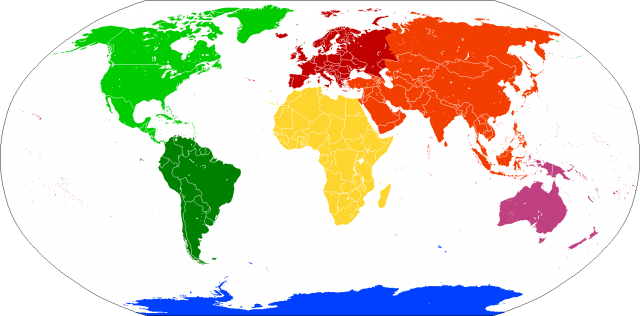continents
THE EARTH IS AN ocean-dominated planet. Only one-third of the planet's surface is dry land. The Earth's land areas include innumerable islands and several larger expanses of land termed continents. A continent is defined as a mass of land significantly larger than an island, completely or nearly surrounded by ocean water. By common agreement among geographers, the Earth's smallest continent is AUSTRALIA while the Earth's largest island is GREENLAND. Australia's area is about 2,966,000 square mi (7,682,000 square km), while the area of Greenland is approximately 836,000 square mi (2,165,000 square km).
The outermost rock layer of the earth is termed the crust. The oceanic crust is composed almost entirely of basalt, a dense igneous rock. The earth's continental crust, in contrast, is composed largely of lighter granitic rock. The continental crust varies greatly in thickness but averages about 35 mi (56 km) thick. The oceanic crust, in contrast, averages only about 4 mi (6 km) thick. Because of the imprecision of the definition, geographers do not agree on the number of the earth's continents. Geographers in the United States commonly recognize seven continents: Asia, Africa, North America, South America, Antarctica, Europe, and Australia.

The ancient Greeks recognized three continents bordering and surrounding the MEDITERRANEAN SEA (the “sea in the middle of the lands”). Africa was almost completely separated from Asia by the RED SEA, while Asia was separated from Europe by the AEGEAN SEA, the Dardanelles, the Sea of Marmara, the Bosporus, and the BLACK SEA. In later centuries, when exploration revealed that Europe was in reality not a separate landmass, Europe was redefined to include extensive land boundaries—in violation of the generally accepted definition of a continent. The boundary between Europe and Asia is now generally accepted to begin at the Aegean and to continue through the Dardanelles, the Black Sea, the CAUCASUS MOUNTAINS, the CASPIAN SEA, the Ural River, and the URAL MOUNTAINS. The Ural Mountains thus separate European Russia from Siberia.
In lists of continents compiled outside the United States, Europe and Asia are often combined as Eurasia. And since Africa and Asia are connected at the Suez Peninsula, Europe, Africa, and Asia are sometimes combined as Afro-Eurasia or Eurafrasia. The International Olympic Committee's official flag, containing five interlocking colored rings, symbolizes the five continents that send athletes to the Olympic Games: Europe, Asia, Africa, Australia, and the single continent of America (North and South America being connected at the Isthmus of Panama). Antarctica, the uninhabited continent, is unrepresented. In modern times, artificial canals have been dug to connect oceans at both Suez and PANAMA. Along with the Red Sea, the Suez Canal is now sometimes said to separate Africa from Asia. The PANAMA CANAL, likewise, is sometimes considered to mark the boundary between the North and South American continents.
All of the continents except Antarctica are roughly triangular in shape, narrower in the south than in the north, a consequence of the way the early super-continental landmass of Pangaea broke apart. Two-thirds of the landmass of the continents occurs in the Northern Hemisphere, particularly in the hemisphere centered on Europe. The large landmass of Eurasia is balanced on the other side of the globe by the large water mass of the South PACIFIC OCEAN. The continental landmass of Antarctica is countered by the ARCTIC OCEAN.
A subcontinent is a subdivision of a continent, a large peninsula that may be separated from the rest of the continent by geographic features of some kind. The most widely recognized subcontinent is the Indian subcontinent, the large peninsula jutting southward from the mass of Asia, isolated from the rest of Asia by the HIMALAYAS. In British English, “the subcontinent” usually refers to INDIA, PAKISTAN, BANGLADESH, and adjacent areas—in the same way that to the British “the continent” refers to the continent of Europe. If one considers Eurasia a continent, though, Europe is merely a subcontinent attached to the larger continental landmass. Other subcontinents might include the Arabian Peninsula of southwestern Asia, the southern cone of South America, and ALASKA (the northwestern peninsula of North America).
Continents are fringed by CONTINENTAL SHELVES, offshore areas of relatively shallow oceanic water. Shallow waters, with depths up to 600 ft (180 m), roughly follow the outline of the continents, up to the point where the continental slopes quickly drop off to the usual oceanic depths of 12,000 ft (3,660 m) or so. In places such as the Grant Banks east of Newfoundland, the continental shelf can be 250 mi (400 km) wide. In other places, especially along tectonically active coastlines such as CALIFORNIA, the continental shelf may be almost nonexistent.
A continental divide is the line along the backbone of a continent separating the drainage basins of the oceans surrounding that continent. The continental divide of North America follows the ROCKY MOUNTAINS from Alaska south to MEXICO, and is then continued through Mexico's Sierra Madre Occidental and the mountains of Central America to Panama. Streams to the west of this divide feed rivers that run to the Pacific Ocean. Streams to the east flow eventually to the ATLANTIC OCEAN or to its connecting seas (Hudson Bay, the Gulf of Mexico, or the CARIBBEAN SEA).